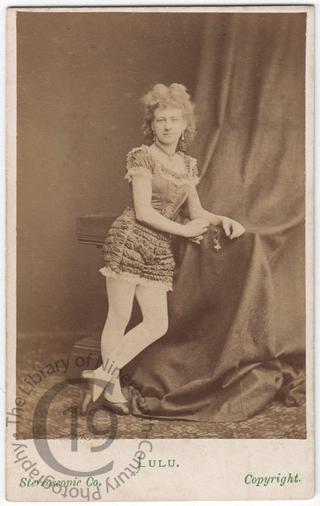
Mlle Lulu
The aerialist Mademoiselle Lulu was a sensation who attracted all London to Holborn in 1871. Within six weeks of her debut she was so famous that she was the subject of witticisms and casual references in the press with no gloss necessary to explain who she was. What no one realized, however, was that Mademoiselle Lulu was a man.
Born Samuel Wasgatt in America, he was adopted by the showman The Great Farini (himself born William Leonard Hunt) who trained him to be a boy acrobat and aerialist and presented him to the public as ‘El Niño Farini, the Wonder of the Age’ during the 1860s. Once his boyhood ended, he grew his hair, changed his costume and enjoyed an even greater success as Lulu, whose act involved being shot high into the air by a powerful spring hidden in the floor and performing a triple somersault before alighting deftly on a narrow platform. A young girl performing perilous feats – and showing her bare limbs – was far more likely to draw the crowds than any male counterpart. Commentators, of which there were a great many, often referred to Lulu’s grace and beauty. According to The Englishwoman’s Domestic Magazine (1 March 1871): ‘The Royal Amphitheatre, Holborn, may confidently lay claim to the possession of the Eighth Wonder of the World in the person of the fearless and graceful Lulu, who is indeed the very empress of gymnasts, accomplishing the most surprising feats with an ease and dexterity that can only be described as marvellous. The attraction of her extraordinary performances is heightened by her youthful and prepossessing appearance,'
Lulu adopted female attire for professional reasons, in order to capture the imagination of a public rapidly becoming jaded by the plethora of male acrobats, aerialists, funambulists and trapeze artists vying for its attention. The success of the hoax depended on maintaining a convincing illusion at all times, even offstage. Although the cross-dressing aerialist was able to conceal her true gender for five years, photographs of Lulu in costume show that as she grew older the deception became increasingly difficult to carry off. While earlier portraits seem entirely convincing, in later photographs her jaw and musculature seem suspiciously masculine. In 1876 she fell from a platform while performing in Dublin and when a doctor was called to examine her injury, the truth came out. By the end of the year Lulu had married Farini’s younger sister, Edith May Hunt. He continued to perform for a few more years, now with short hair and a moustache but strangely still wearing Lulu’s familiar costume. According to one source, he later emigrated to Canada, where he settled down as a photographer and portrait painter.
Photographed by the London Stereoscopic and Photographic Company.
Code: 126478




